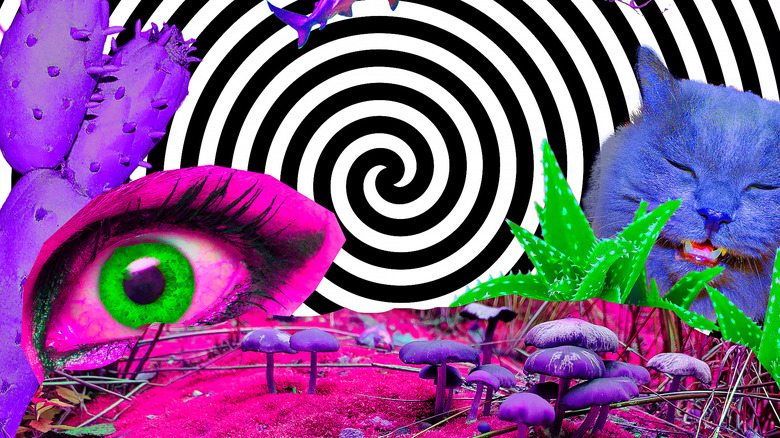How Centuries-Old Hair Revealed Evidence Of Drug Use In The Bronze Age
So imagine you're wandering the woods some tens of thousands of years ago. You're a gatherer, sometimes a hunter, and on good days maybe a bit of both. Otherwise, you're more of a sitter and sleeper. One day you find a strange little plant at the base of a tree that has unusually shaped leaves. You might lean close and peer, poke it with a finger, or maybe give it a smell. But maybe you've got a friend — let's call him "Zach" — who just rushes up to the plant, howls "YOLO!" and stuffs it in his mouth and chews. And if Zach starts fritzing out and rambling about psychedelic mastodons, you know you've hit the drug jackpot. Fast-forward tens of thousands of years and you've got boutique CBD-infused lip balm sold for outrageous prices.
Yes, humans have always loved their mind-altering substances. The world's oldest extant megalithic structure, Gobekli Tepe in modern-day Turkey, has these giant, 40-gallon cisterns used for holding beer — the site is over 12,000 years old. Nine-thousand-year-old beer was also recently discovered at the Qiaotou archeological site near Zhejiang, China. On the smokable side of things, we have Chinese funeral goers blazing out about 2,500 years ago. Later on, horse-riding, nomadic Scythians brought pot with them from the Altai steppes of Central Asia to ancient Greece, and bam: instant Oracle at Delphi high on vapors. And now, we've got 3,000-year-old hair that shows evidence of hallucinogenic drug use off the coast of Spain.
Chemicals locked in red-dyed hair
Until the present, as CNN reports, we were missing certain pieces of the ancient blazer puzzle. For instance, did folks ever straight up eat plants as we described in our earlier hunter-gatherer story? Now, thanks to the intrepid, cave-exploring work of researchers at Spain's University of Valladolid, we know that they did. And they didn't just munch on any plant, but plants that contain atropine and scopolamine, used in the modern day to dilate eyes before eye exams. These chemicals produce intense, hallucinatory, and "violent and unpleasant" visions when eaten, as Dagmara Socha says, a researcher at the University of Warsaw's Center for Andean Studies. Not a good trip.
The current study comes from the journal Nature and describes researchers reaching their conclusions by examining the chemical composition of locks of hair. The hair was found along with the remains of 200 people in a burial site on the small island of Menorca in the Mediterranean Sea off the Spanish Coast. The site, located within the seven-chambered cave Es Càrritx, was discovered in 1995 and used for funereal purposes all the way from 1,400 to 800 B.C.E. Interestingly enough, the hair was dyed red as part of some death rite, combed, cut, and placed in tubes of antlers or wood. These containers were then placed in a chamber separate from their owners. This very mysterious and ritualistic find now constitutes the oldest current evidence of drug use on the European subcontinent.
Nightshade at funeral rites
Researchers in the current study identified the psychoactive chemicals by their mass. The chemicals all belong to plants still found on the island of Menorca, like mandrake, white henbane, and devil's snare. Whether or not these plants — which largely belong to the Solanaceae plant family, i.e., nightshade — were crushed and mixed together, added to some liquid and drank, gnawed on raw, etc., is unclear. When speaking of the ancient society who used these drugs, lead researcher Elisa Guerra-Doce on CNN said, "We suggest that maybe there were certain people — religious specialists — who controlled their use of these drugs," continuing, "All this evidence made it seem that maybe certain individuals deserved this hair treatment, and those individuals were the ones who consumed the drugs."
Similar drug use across the world tends to imply grisly or sexual intent. The Chibcha people in modern-day Colombia fed Brugmansia to slaves and wives of dead tribal lords to keep them calm while they were buried alive with their enslavers or husbands. Psychoactive compounds were also found in the severed head of a sacrificed child in Peru near the Nazca Lines. Maya and Aztecs, meanwhile, used Datura stramonium as an aphrodisiac. Time will tell if the find at Es Càrritx involved anything similar. But at minimum, Es Càrritx shows us that drug use was a much, much more serious and solemn Bronze Age affair than any kind of casual, weekend smoke-'em-up.


